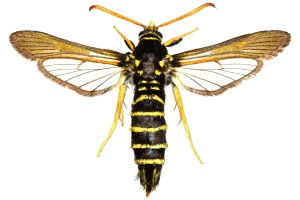

 +12Kontinente:EUAS
+12Kontinente:EUAS2. Diagnose
2.1. Weibchen
2.2. Erstbeschreibung
3. Biologie
3.1. Nahrung der Raupe
- [Salicaceae:] Salix babylonica (Echte Trauer-Weide)
- [Salicaceae:] Salix alba (Silber-Weide)
- [Salicaceae:] Salix sp. (Weide)
- [Salicaceae:] Populus alba (Silber-Pappel)
Georgiev (2015) meldete die Art aus Bulgarien, wo die Raupe zunächst in Zweigen und im Stamm älterer, dann aber auch in Stängeln von einjährigen Salix caprea-Schösslingen gefunden wurde. Er erläutert ansonsten: "It is connected with Salix spp. (S. alba L.) and Populus alba L. (Laštůvka, Laštůvka, 1995, 2001). The larvae develop 1-2 years in tumours of branches and adult emergence occurs in June-July." Er ergänzt: "In conclusion it must be noted that P. diaphana has never been observed as a pest. It is very rare and local species in all its distributional range and, therefore, the present record in Bulgaria is important as an element of country’s biodiversity."
Bąkowski & Askarianzadeh (2023) schreiben in ihrem Abstract: "The research on clearwing moths in Tehran Province (central Iran) has revealed that P. diaphana is a serious new pest that causes significant damage to babylon weeping willow trees Salix babylonica L. (Salicaceae)."
(Autor: Erwin Rennwald)
4. Weitere Informationen
4.1. Nomenklatur
Da Schawerda (1922: 165) das Taxon als „ab.“ (Aberration) beschrieb, ist der Name diaphana nach dem ICZN nicht unter seiner Autorschaft verfügbar, sondern erst unter der Autorschaft von Dalla Torre & Strand, 1925.
(Autor: Jürgen Rodeland)
4.2. Faunistik
Georgiev (2015) meldete die Art aus Bulgarien. Er diskutiert zur Gesamtverbreitung: "The Northeast Mediterranean P. diaphana is distributed in Croatia, Bosnia and Herzegovina, Serbia, Montenegro, FYRMacedonia, Bulgaria (Laštůvka, 2013), Asiatic part of Turkey, Azerbaijan and Iran (Garrevoet et al., 2005)."
(Autor: Erwin Rennwald)
4.3. Literatur
- Bąkowski, M. & A. Askarianzadeh (2023): Morphology of the last instar larva and pupa of Paranthrene diaphana (Dalla Torre & Strand 1925) (Lepidoptera: Sesiidae), a serious pest of the babylon weeping willow trees in Iran. — Zootaxa, 5270 (3): 584-592. DOI: 10.11646/zootaxa.5270.3.9. [Abstract auf mapress.com] [Sekundärzitat]
- Erstbeschreibung: Dalla Torre, K. W. van & E. Strand (1925): Lepidopterorum Catalogus 31: 1-202. Berlin (W. Junk).
- Schawerda, K. (1922): Zwölfter Nachtrag zur Lepidopterenfauna Bosniens und der Herzegowina. — Verhandlungen der Zoologisch-Botanischen Gesellschaft in Wien 71: 145-170 [PDF auf zobodat.at].
- Georgiev, G. (2015): Paranthrene diaphana (Lepidoptera: Sesiidae) – a new xylophage of goat willow (Salix caprea) in Bulgaria. — Silva Balcanica, 16(2): 95-97.[zum PDF-Download auf researchgate.net]
















